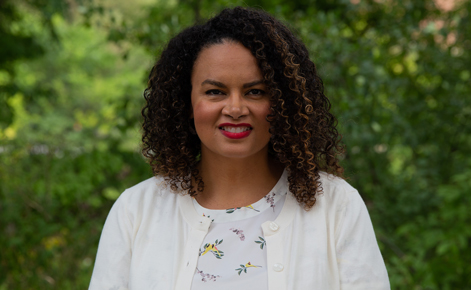There is a scene in a book recently published by Michigan State University Professor Terah Venzant Chambers that shows how one moment can completely alter how a person interacts in a classroom environment, perhaps permanently.
In this example, “Makayla,” a Black Advanced Placement (AP) student, drops a pencil. Makayla picks it up and says: “It ain’t broke,” and goes back to writing. Around Makayla, white students repeatedly ask: “Is it broken?” The question is followed by giggles. Makayla realizes she is being made fun of, and it puts her on notice. Now and forever in that classroom space, she will be hyper vigilant of what she says, how she says it and how her Blackness is always on display for scrutiny.

It’s one vignette of many in Venzant Chambers’ book, “Racial Opportunity Cost: The Toll of Academic Success on Black and Latinx Students” (Harvard Education Press, 2022). The book shares real-life examples of high-achieving students like Makayla who regularly navigate educational spaces in which they are often a minority, and are made to feel like such.
In other words, as Venzant Chambers puts it: “Black and Latinx students are successful in school—but at what cost?”
Part of the challenge comes from who is considered a high-achieving student. Who determines what “successful” means, and by what measures? Things like grades, test scores and enrollment (or lack thereof) in academic spaces could impact students’ perceptions of themselves.
“There are many Black or Latinx students who could take AP- or honors-level classes, but who choose not to,” explains Venzant Chambers. “This book uncovers why. These spaces are dominated by students and teachers who don’t look like them and feature curricula that doesn’t reflect who they are, so they choose not to enroll.”
And even in cases where students do enroll, the situation is frustratingly similar because, like Makayla, they can be made to feel like they don’t belong.
“The students may end up blaming themselves,” Venzant Chambers says. “These occurrences are often the result of a culture set up to define academic success as something incredibly narrow, something that doesn’t look or act like them. Thus, harmful and incorrect stereotypes perpetuate that Black or Latinx students can’t be successful in these environments.”
The book calls upon educators to create spaces that break these norms and help all students feel welcome, seen and heard. It similarly is a call to action for teacher education programs. Higher education institutions, Venzant Chambers says, should prepare future educators to cultivate change. (MSU’s Teacher Preparation Program recently expanded its efforts on educating about social justice earlier and more regularly throughout the program.)
“I hope people come away from the book with knowledge on how they can implement change now, where they are,” said Venzant Chambers, also the associate dean at the MSU Graduate School. “Every step of change has the capacity to improve lives for students. You can do this. We can do this. We can make a difference, together.”




